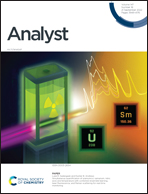Activatable endoplasmic reticulum-targeted NIR fluorescent probe with a large Stokes shift for detecting and imaging chymotrypsin†
Abstract
In this work, the first endoplasmic reticulum-targeted near-infrared fluorescent probe, ISO-Chy, with a dicyanoisophorone derivative as a fluorophore is reported by introducing the recognition group of 4-bromobutyl for chymotrypsin detection. The probe can be easily synthesized and has shown satisfactory sensitivity and selectivity to chymotrypsin. Meanwhile, ISO-Chy has a large Stokes shift (135 nm) to minimize self-absorption and interference from autofluorescence and then generate significant fluorescence enhancement upon incubation with chymotrypsin. Additionally, ISO-Chy has an excellent ability to target the endoplasmic reticulum, along with preferable Pearson's correlation coefficients (Rr) of 0.9411 and 0.9522 in P815 cells and HepG2 cells, respectively. Moreover, ISO-Chy was successfully utilized to visualize endogenous chymotrypsin in P815 cells and HepG2 cells and was first used to detect chymotrypsin activity in HepG2 tumor-bearing mice. These findings indicate that ISO-Chy could be an effective tool for detecting endogenous chymotrypsin activity, supporting its use for investigating chymotrypsin function in pathologic processes.



 Please wait while we load your content...
Please wait while we load your content...